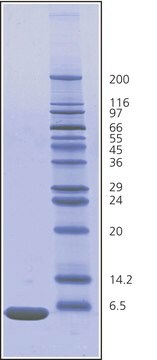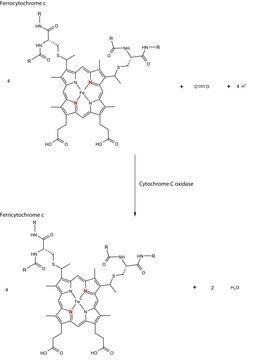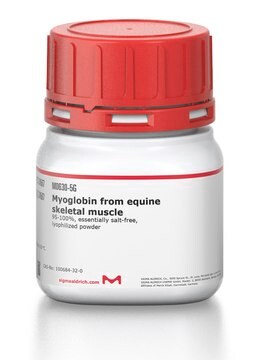C9616
Anti-Cytochrome c antibody produced in sheep
~0.5 mg/mL, affinity isolated antibody, buffered aqueous solution
Sinónimos:
Anti-CYC
About This Item
Productos recomendados
origen biológico
sheep
conjugado
unconjugated
forma del anticuerpo
affinity isolated antibody
tipo de anticuerpo
primary antibodies
clon
polyclonal
Formulario
buffered aqueous solution
mol peso
antigen 15 kDa
reactividad de especies
rabbit, rat, human, canine
concentración
~0.5 mg/mL
técnicas
immunohistochemistry (formalin-fixed, paraffin-embedded sections): 20-40 μg/mL using human heart tissue
indirect immunofluorescence: 5-10 μg/mL using human MCF-7 cells
western blot: 0.1-0.2 μg/mL using whole extracts of MCF−7, Jurkat, Rat−1, MDCK cells and extract of rat kidney or rat heart
Nº de acceso UniProt
Condiciones de envío
dry ice
temp. de almacenamiento
−20°C
modificación del objetivo postraduccional
unmodified
Información sobre el gen
human ... CYCS(54205)
rat ... Cycs(25309)
¿Está buscando productos similares? Visita Guía de comparación de productos
Descripción general
Inmunógeno
Aplicación
- immunocytochemistry
- immunostaining
- immunoblotting
- immunohistochemistry
Acciones bioquímicas o fisiológicas
Descripción de destino
Forma física
Cláusula de descargo de responsabilidad
¿No encuentra el producto adecuado?
Pruebe nuestro Herramienta de selección de productos.
Código de clase de almacenamiento
12 - Non Combustible Liquids
Clase de riesgo para el agua (WGK)
nwg
Punto de inflamabilidad (°F)
Not applicable
Punto de inflamabilidad (°C)
Not applicable
Elija entre una de las versiones más recientes:
¿Ya tiene este producto?
Encuentre la documentación para los productos que ha comprado recientemente en la Biblioteca de documentos.
Nuestro equipo de científicos tiene experiencia en todas las áreas de investigación: Ciencias de la vida, Ciencia de los materiales, Síntesis química, Cromatografía, Analítica y muchas otras.
Póngase en contacto con el Servicio técnico



